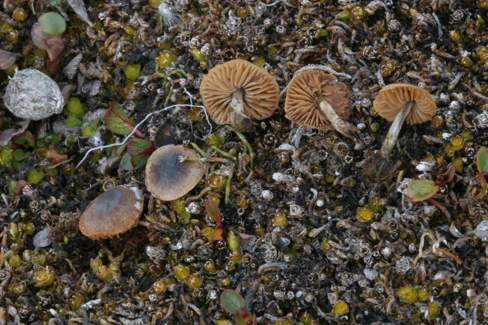 Hebeloma fuscatum (Photo: H. J. Beker)
Hebeloma fuscatum (Photo: H. J. Beker)Taxonomy
Full name: Hebeloma fuscatum Beker & U. Eberh., Hebeloma (Fr.) P. Kumm.: 133 (2016)Genus: Hebeloma
Section: Hebeloma
Subsection: 'subsect1'
Types: SVALBARD: London (78.963°N, 12.0499°E, alt. approx. 10 m a.s.l.) on soil in arctic tundra under Salix polaris, 18 Aug. 2007, H.J. Beker, M.L. Beker (Holotype. herbarium acc. no. BR 5020184125561, HJB12039).
- arrow_drop_downarrow_drop_upEtymologyFrom fuscatus– darkened, to emphasise the dark coloured pileus of this species.
- arrow_drop_downarrow_drop_upDiagnosisHebeloma fuscatum has a persisting cortina and lageniform or ventricose cheilocystidia and is, therefore, clearly a member of H. section Hebeloma. Within this section, it can be differentiated on the basis of the amygdaloid and often limoniform spores, distinctly to rather strongly dextrinoid, and of average length less than 15 µm, and the number of full length lamellae less than 40, in combination with the arctic or alpine habitat.
References
Description
- arrow_drop_downarrow_drop_upThresholds
Description of Hebeloma fuscatum based on 29 collections
- arrow_drop_downarrow_drop_upMacroscopic descriptionPileus: (7) 8–30 (41) mm diameter; shape often convex, occasionally umbonate, rarely broadly umbonate; characters often remains of universal veil, occasionally tomentose, rarely hygrophanous; margin characters smooth, occasionally involute; viscosity tacky when moist; colour variation often two color, occasionally unicolour; colour at centre occasionally fuscous, dark brick, sepia, greyish brown or brick.
Lamellae: attachment emarginate; maximum depth 4–7 mm; number of complete lamellae 24–32; presence of tears absent; white fimbriate edge often present, occasionally weak.
Cortina presence: yes.
Stipe: (8) 11–48 (70) x 1–6 (8) {median} x 1–9 (12) {basal} mm; stipe Q 2.6–13.0; base shape often cylindrical, occasionally clavate or tapering; floccosity usually fibrillose, often pruinose at apex; rooting no; thick rhizoids at base absent;
Context: Texture firm; stipe interior often stuffed, occasionally hollow; stipe flesh discolouring usually yes, rarely no; slenderness measure 1.8–28.2; smell often raphanoid, rarely odourless or weakly raphanoid; taste Not recorded.
Spore deposit colour: Not recorded.
Exsiccata characters: pileus blackening.
- arrow_drop_downarrow_drop_upMicroscopic descriptionSpores: shape amygdaloid, usually limoniform, occasionally ovoid; colour in microscope brown; guttules yes. papilla often yes, occasionally very strongly; Spore Code: O1 O2; P0 (P1); D2 D3.
Basidia: (24) 25–36 (41) x 7–11 (12) μm; ave. Q 3.0–4.1; spore arrangement 4 spored;
Cheilocystidia: main shape lageniform or ventricose, occasionally cylindrical, rarely pyriform; special features observed often septa, occasionally basal thickening, geniculate or median thickening, rarely apical thickening, clamped septa or many collapsed in exsiccata; cheilocystidia ratios: A/M = 0.90–1.17; A/B = 0.46–0.67; B/M = 1.75–2.56.
Pleurocystidia: usually none seen, rarely seen.
Ixocutis: epicutis thickness (measured from exsiccata) up to 30 μm; ixocutis hyphae width up to 6 μm; ixocutis hyphae encrustation yes; shape of trama elements beneath subcutis thickly sausage-shaped up to 19 μm wide.
Caulocystidia: Similar to cheilocystidia but larger, up to 75 μm.
- arrow_drop_downarrow_drop_upSpore measurements
- arrow_drop_downarrow_drop_upCheilocystidia measurements
- arrow_drop_downarrow_drop_upHabitat and distributionHebeloma fuscatum's preferred habitat appears to be arctic tundra. Where only one possible associate was recorded, the most commonly recorded associate was Salix (86.7%) but Picea (13.3%) were also recorded. In these cases the most commonly recorded families were Salicaceae (80.0%) and Pinaceae (20.0%). We have additional records where Alnus (10.5%), Larix (5.3%), Pinus (5.3%), Betula (5.3%) and Abies (5.3%) were recorded as possible associates, but in these cases a number of possible associates were mentioned. Overall the most commonly recorded families are Salicaceae (84.2%), Pinaceae (26.3%), Betulaceae (15.8%) and Polygonaceae (5.3%) The growth habit of our collections was often scattered, occasionally gregarious and rarely solitary.
According to our current data, the species is found on multiple continents with collections found in Europe (59.3%) and Northern America (40.7%). On these continents, collections has been found in the WWF biomes The World Wildlife Fund (WWF) have divided the world into 867 terrestrial ecoregions. The ecoregion here is estimated by mapping from the GPS coordinates of the collection using data made available by Dinerstein et al (2017). Use this webtool to explore the ecoregions visually or see a full list of current ecoregions on Wikipedia. unknown biome (37.5%), tundra (29.2%) and temperate conifer forests (16.7%), specifically including the ecoregions: Unknown region (37.5%), Kalaallit Nunaat Arctic steppe (29.2%) and Alps conifer and mixed forests (12.5%). From collector information, it appears collections have been found in the 4.1 Grassland – Tundra (53.6%), 1.1 Forest – Boreal (14.3%) and 5.10 Wetlands (inland) – Tundra wetlands (inc. pools and temporary waters from snowmelt) (10.7%) IUCN habitats We map from the collector's description of the habitat to the International Union for Conservation of Nature (IUCN)'s definition using a standardised set of rules. Please see this page for a full list of IUCN habitats..
Within Europe we have records from the North (Svalbard), the Centre (Germany and Poland), the Southwest (Italy and France) and the Southeast (Italy). Specimens have been collected from 45.4°N to 79.0°N.
Within Northern America we have records from Subarctic America (Greenland), Western Canada (Manitoba), Eastern Canada (Quebec) and Northwestern U.S.A. (Washington).
- arrow_drop_downarrow_drop_upMolecular resultsHebeloma fuscatum is part of the clade with H. clavulipes where molecular divergence is generally low (short internal branches). However, collections of H. fuscatum form well-bootstrap-supported clades in ITS, RPB2 and the five-locus tree in Fig. 23 and a monophylum (bootstrap support < 80%) in the Tef1a result. Within its section, H. fuscatum is thus one of the molecularly well supported species. We are not aware of any published ITS sequences that are likely to belong to this species.
- arrow_drop_downarrow_drop_upCommentaryWith the persistent presence of a cortina and the lageniform or ventricose cheilocystidia, this taxon clearly belongs in H. section Hebeloma. Within this section, it can be differentiated on the basis of the amygdaloid and often limoniform spores, distinctly to rather strongly dextrinoid, of average length less than 15 μm, the number of lamellae less than 40 and the arctic or alpine habitat. Hebeloma fuscatum is morphologically most similar to both H. clavulipes and H. hygrophilum, but these species occur in different habitats.
Geographic distribution
Phenology
- arrow_drop_downarrow_drop_upAdditional cited collections